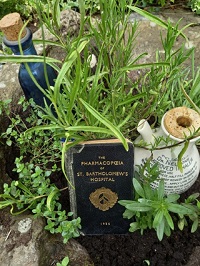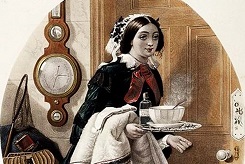Health and Welfare
Health and diseases in Chinnor
Previous generations relied on the countryman’s wife to cope with sickness and accidents as best she could until help arrived, self help and home remedies prevailing. In terms of availability of medical and nursing care, Chinnor appears to have been well served; professional help being provided historically and traditionally by a wide range of practitioners including local clergy. Through the ages the provision of medical care in Chinnor was actually a mixture of lay intervention, midwives with varying degrees of competence, and general practitioners who, although provided a caring and personal service to the residents, still charged a fee to the uninsured. In addition, fees were needed for nursing and midwifery services, and it was cost which informed the level of service available.
Nursing & Midwifery
One of the first people that residents would turn to if unwell, being less expensive than the doctor, was the village nurse and, in Chinnor, Mabel Howlett remembered the district nurse who lived in a council house in Station Road. During the 1920s Mabel visited the nurse following an accident with her sledge when she required splinters to be removed from her behind. The scope of nursing care provision in Chinnor can be assessed by using evidence from oral and written testimony and official records. The historiography of district nursing has been confined to a footnote in the history of general nursing appearing simply as book chapters, until Helen Sweets’ account in 2008.
A fuller account of nursing generally is available in the document below

Herbs found in the churchyard

Nurse & Midwife

Pandemics
Pandemics
Before the advent of antibiotics and sanitary reforms in the 19 century infectious illnesses whether local outbreaks, epidemics or pandemics, were a very real threat to life. Although antibiotics are not effective against viruses they are effective in addressing any superseding bacterial infections.
Since available records for Chinnor, starting in 1622, there have been numerous outbreaks of infections although it is not possible to assign an increase in burials to a reported outbreak but given the links between Chinnor, Oxford Wycombe and Thame transmission of infection would have been easy.
Chinnor in lockdown 1643
In 1643 there was an outbreak of infection in Thame having been brought from the siege of Reading by the Parliamentary army. According to historical reference this was of an epidemic of a New Disease which has not been identified but Bell suggests it could have been mixture of conditions common to armies such as camp fever, dysentery, typhus or typhoid. Chinnor was put into lockdown with no contact with Thame after July, but the Stevens family of Chinnor High Street broke the ban.
In August 1643, Richard Stevens died and in September, John Stevens, Clement Stevens and Jeffery, s. of Clement, all died on and in Jan 1643 (44), Margaret Stevens d of Clement died..
Ref John Bell Chinnor archives.
Discussion with Rev. Dr. Jackie Barr Rector of the united parishes of Chinnor. 2/8/21
Jacky became rector at the end of January 2020 with the aim to start as rector in July following a months break. However, Covid-19 lockdown was announced on 23rd. March and Jackie took the painful decision to close the church. This was counter intuitive, counter cultural and counter faith, but she felt that the responsibility of gathering people together and the threat of a virus outbreak with in the congregation and the village was too serious to ignore. She felt the whole experience of locking the church was a profound shock to her personal lived experience of her ministry. Key to church life following this was how to keep the congregation together particularly with Easter being cancelled and this led to the instigation of online services. With IT help these were put on the church website later on Facebook and it was noted that attendance increased during lockdown. On WhatsApp the services were shortened to 10 minutes and hymns were spoken rather than sung. To help with all this Jacky’s daughter came home from university. Like many university students she felt confused and disorientated but kept herself occupied with helping with parish administration.
Inhouse booklets were printed for parishioners who did not have Facebook etc. During this very difficult period Jacky had the total support of her clergy although some of the laity wanted the church to be kept open. This led to some painful conversations as the reasons for the closure were explained. One aspect of lockdown which caused a deal of distress was having only graveside funerals rather that a full service in the church. Contact with the ministry team was done by zoom.
Daughter Zoe, home from university and on her way to Dundee to do a PhD was equally disorientated and like many others very disappointed not to have a graduation ceremony. Jacky’s third daughter Heather was working from home in London.
Summer 2020
The church was open in August with a reduced timetable between the parish churches but it was noticeable that many members of the congregations had felt the pressure of the pandemic and were glad to be together again. The harvest festival was held out side on Mr, Nixey’s farm and because to was held out of doors singing was allowed. As Christmas approached the incidence of COVID increased and traditional Christmas programmes were cancelled. The church was closed again after Christmas laity did not want the church closed but Jacky decided to err on the side of caution.
January 2021 was the worst month for funerals including two couples who were buried within a week of each other and in addition Jacky was acting as locum for other parishes whose priest was sheltering.
In April the church opened again for Easter although again no singing was allowed. This brought to everyone’s attention to the comparative importance of the different Jacky, who said she felt the responsibility of keeping the congregation safe a heavy burden knowing how important the church was in peoples lives particularly the sense of community it engendered and the balance of work within the ministry was skewered towards funerals often 2 a week with no more uplifting occasions such as weddings and christenings.
Dental care
Dental care in Chinnor during the early 1900s, according to Mr. Neighbour, was provided by his grandfather, a carrier by trade, who would set up a dentist chair in his front garden at the weekend and, with a tooth extractor he had had made by the local blacksmith, (modelled on the nail puller used by the blacksmith for his farrier work) was open for business. If the tooth broke, he would use a tool called a gummer which was a knife to cut the gum from the tooth. Mercifully, by 1928 according to Kelly’s Directory, Chinnor had a visiting dentist attending on Thursdays from 2-4 pm.
Dental inspections undertaken in schools in Oxfordshire between 1908–1915 in the Medical Officers Reports, indicated that 62.09% of children had clean teeth, 27.07% ‘somewhat dirty’ and .4% were deemed ‘very dirty’. Dental hygiene was considered to be so bad that in 1909 it was decided that tooth brushes would be provided via the schools’ head teachers. Concerns regarding dental health continued with 54% of girls and 56% of boys having dental caries. In 1912 and in May 1915, 229 children were inspected in Thame and 140 had extractions under gas. The state of dental care within the country was generally, and continued to be, very poor. The dental profession was only created in legal terms in 1921 when the law prohibiting the practice of dentistry by unqualified persons not on the register of dental practitioners was passed. In 1938 there were 14,780 on the register. A later report of 1937 highlighted the continuing problem of tooth decay and estimated that 95% of elementary school children were affected. To illustrate the impact of these figures the report further stated that in1934 dental disease was one of the most frequent reasons for rejecting military recruits quoting 96% of recruits to the navy and 98% to the army needed dental treatment with the Royal Air Force needing to provide on average 5.1 fillings per accepted recruit. The report further confirmed the role of dental caries as the causation of a great deal of ill health. However, the report noted that diet was not always a factor some healthy and adequately fed persons still had caries. It was suggested that this was as much a lack of finance as ignorance of the importance of dental health.
Dental treatment was not always available under health insurance schemes and although the School Medical Service was supposed to provide dental inspection and treatment to school children the service was woefully inadequate to the demand. This is illustrated by two quotations from the Rural Education Report, 1923 for example, ‘The Oxfordshire dentist has not visited us since the war’ and ‘A dentist used to visit the school but has not been (visited the school) for about five years’. Interviewees for this thesis were unanimous in their negative comments about the school dentist, who according to John Neighbour ‘came far too often,’ and the sight of his large American car in the school play ground ‘made his stomach turn over’. Wendy Harris had a very traumatic experience with a haemorrhage which resulted in her not visiting a dentist until she was 27 when she had all her teeth out. Personal dental care in Chinnor included the use of Gibbs dentifrice a pink cake of dental paste which was retailing in 1932 at 1s. per large size having maintained its cost from 1923.
Documents
Pandemics in Chinnor
The importance of water
Family & community care
Provision of Medical Care
Nursing midwifery and handywomen
Housing
Infectious Diseases
Incidence of Infectious Diseases.
Appendix B
Incidences of Tuberculosis in Chinnor
Case study of Tuberculosis in Chinnor
Analysis of burials in Chinnor in respect of pandemic illness
Living through a 21st Century pandemic